“This vomit bag and the price of one admission will enable you to see…the first film rated ‘V’ for violence! Mark of the Devil: positively the most horrifying film ever made!”

By Paul Mavis
I recently updated my old, compromised Cheezy Flicks Entertainment “Yack Pack” standard DVD release of Mark of the Devil, the notorious 1970 torture-porn horror movie from West Germany starring Herbert Lom, Udo Kier, Olivera Vuco (Katarina), Reggie Nalder, Herbert Fux, Gaby Fuchs, and Ingeborg Schöner, to Arrow Films‘ spiffy Blu version. And mightly glad I was to do so, I might add. A perennial drive-in classic that memorably hit ballyhooed exploitation heights when its releasing company (Hallmark Films) handed out vomit bags during its 1972 North American run (god that’s brilliant marketing), Mark of the Devil, no doubt about it, is, at times, an unpleasant movie to watch. However, you have to give the moviemakers credit: unlike Hammer and AIP, they’re not f*cking around here. And let’s be honest: we really want it to be unpleasant. Don’t we?
Click to order Mark of the Devil on Blu-ray:
In a secluded Austrian mountain village in the early 18th century, local witchfinder Albino (Reggie Nalder) and his lieutenant, Advocato (Johannes Buzalski), rule through systematic fear, torture, and execution. Women who catch their fancy are raped and then summarily sentenced to death, and any man who opposes them is either threatened with torture or killed outright. The Church has determined that a new man is needed in town, though, and news of the arrival of Lord Cumberland (Herbert Lom), master witchfinder, is met with both anticipation and dread.

The initial behavior of his devoted assistant and point man, Count Christian von Meruh (Udo Kier), seems to indicate a more just, fair way of determining just who is or isn’t a witch, such as when Christian rescues voluptuous barmaid (is there any other kind?) Vanessa Benedikt (Olivera Vuco), from the spidery clutches of Albino. Soon, though, Christian begins to question his mentor’s motivations and indeed, the Church’s, when Vanessa is unfairly imprisoned on a trumped-up witchcraft charge.

Mark of the Devil is the kind of movie that is always tricky to either defend or defame. It can (if you don’t have the stones to stand your ground) put the champion in a very uncomfortable moral position (“You’re recommending a movie that revels in torture, you sick piece of garbage?”), while lining up the attacker as a hypocrite (“Oh, so Mark of the Devil is evil, but according to you, Peckinpah’s titillating rape scenes are okay to ‘enjoy’ on an aesthetic level because they’re ‘commenting’ on something or other…and besides, you’re not really enjoying them, anyway, right? Uh huh…”).
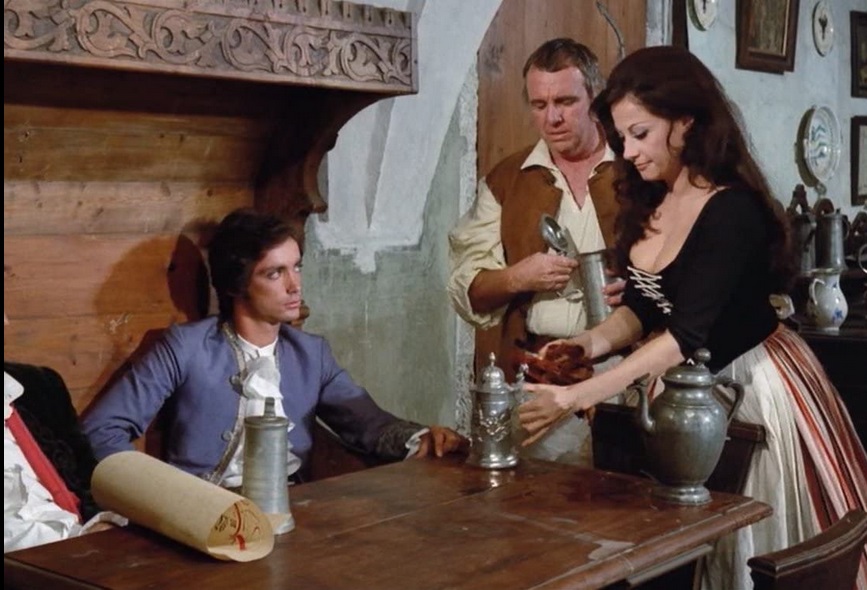
Searching for and finding the “valid” aesthetics of a particularly questionable movie will usually smooth over any potential qualms a reviewer may have with a movie’s violence. Discretion on the part of a moviemaker or studio—even if the ultimate intent is to still titillize with almost-visualized mayhem and perversion—is always welcomed, too, if that reviewer is afraid of offending readers, or more importantly, the people that cut his or her checks (early Hammer and AIP efforts are good examples of exploitation peddlers who routinely got “passes” for content that, had their stories been completely and fully realized on the screen, minus their own self-censorship, might have had critics turning up their noses).
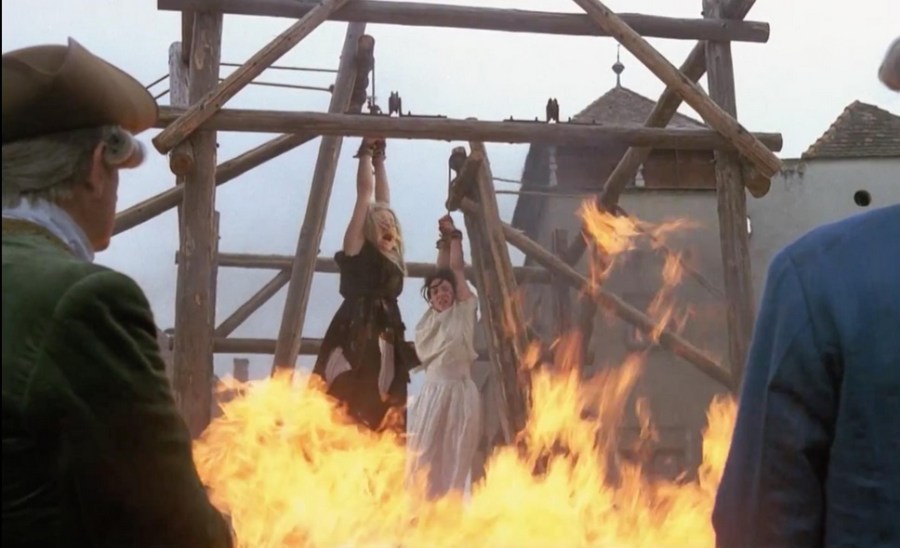
However, if we’re honest with ourselves, then we have to acknowledge that both of the above ameliorations are just that: aesthetic balms based on a fluctuating scale of “taste” that allow us to actually “enjoy” something we’re not really supposed to enjoy (at least enjoy “out loud,” as it were). When I was growing up, movies like Spartacus and The Vikings would often show up on the late, late show. Now, as kids we thought it was cool to see a close-up of a warrior’s arm hacked off in the former, and Kirk Douglas’ eye ripped out by an falcon in the latter—an adolescent appreciation for sensationalism that’s really not too far removed from why little children love their parents to read them fairy tales like Hansel and Gretel (a simple, innocent little story about kids being baked in ovens).
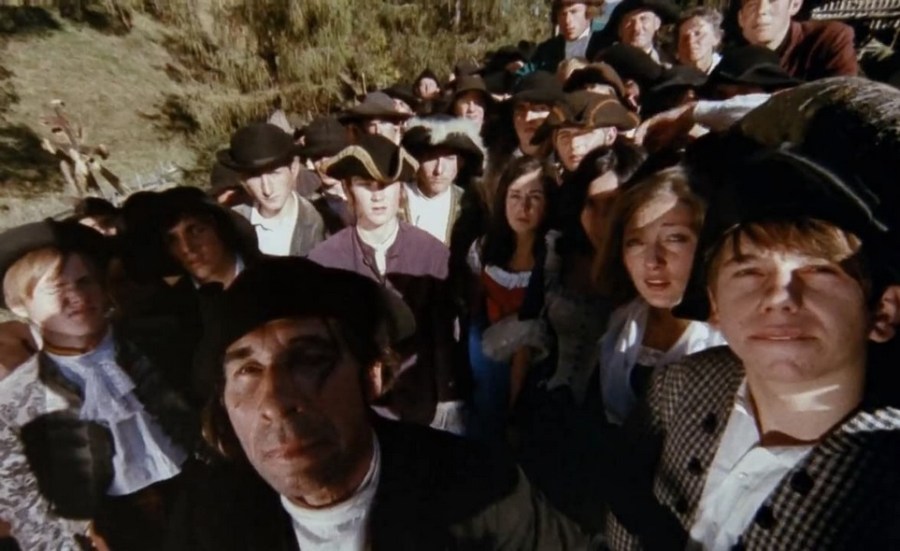
The fairy tales scared us…but it was ultimately a safe and even reassuring experience because it wasn’t really “real.” It was happening in the pages of a book, or on a movie screen, and then in our imaginations, with Mom and Dad there to say everything was okay in the end. It wasn’t actually happening to us. Certainly movies are no different in terms of being vehicles for fantasies (right or wrong fantasies, that is) that “safely” end when the lights in the theater come back up.
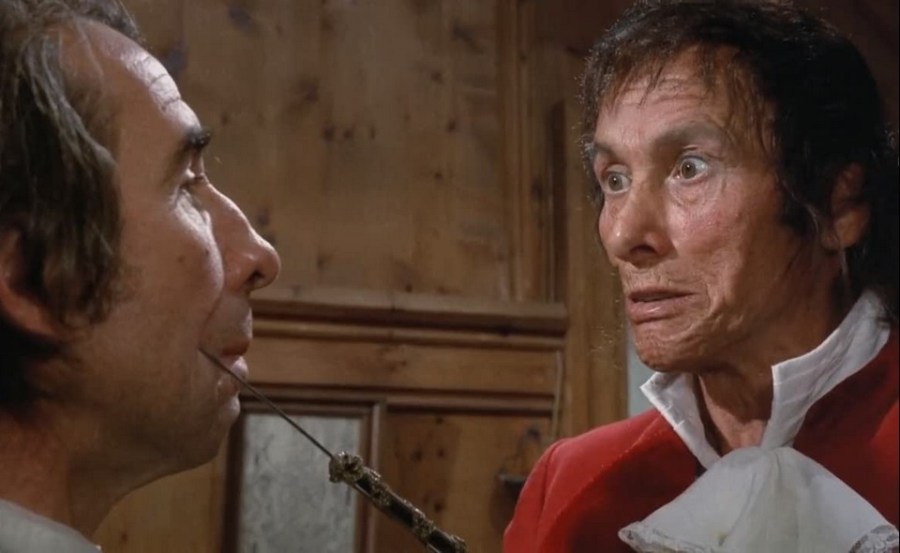
And of course it’s not just kids who pleasurably experience violence on the screen the way we did when we laughed at Sean Connery, in Thunderball, shooting a spear gun into a henchman’s stomach (“I think he got the point”). All you have to do is read the rhapsodic, rationalizing critical appreciations for once-envelope pushing movies like Bonnie and Clyde and The Wild Bunch, through art house favorites like Henry: Portrait of a Serial Killer, to mainstream successes like the Saw franchise and the (highly derivative) works of former video clerk Quentin Tarantino, to see high-minded reviewers speciously searching for and codifying all kinds of reasons to “enjoy” the same level of violence that they would frown upon in a foreign cheap-jack drive-in movie like Mark of the Devil.
RELATED | More 1970s film reviews

If you just throw Mark of the Devil out as sensationalistic garbage solely because it features sadistic torturing for voyeuristic effect, an effect that makes you feel uncomfortable…then you had better have your bullsh*t meter set to “zero” if you’re making a thumbs-up case for the other movies mentioned above (really…isn’t this whole argument moot when an Academy Award-winning actor like Anthony Hopkins, in a mainstream Hollywood movie, can have a thoroughly outrageous scene like the one in Hannibal, where he cooked and ate some guy’s brain, in front of the still-alive victim, and nobody called for the end of Western civilization?).
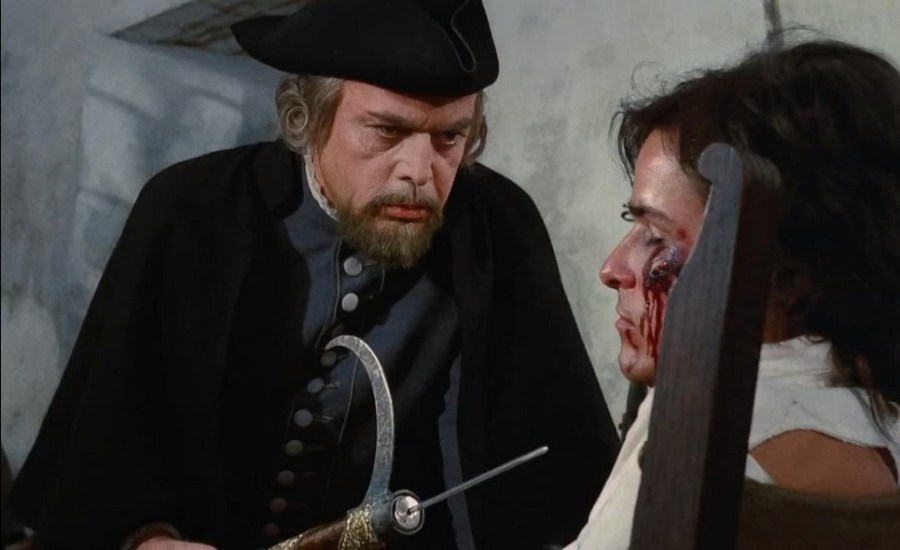
Movie lovers may not feel “clean” admitting it, but the basic “attraction/repulsion” fascination element of watching Mark of the Devil‘s most notorious scene—the ripping out of Gaby Fuch’s tongue with a pair of tongs—works on exactly the same level as a moviegoer marveling at how beautifully the blood spurted out of William Holden in The Wild Bunch, and how excitingly people burned up in The Towering Inferno, and how spectacularly John Hurt’s stomach blowed up good (“It blowed up real good!”) in Alien. Of course it would be horrible if we were watching these events happen “for real.” But of course they’re not “for real,” are they? They’re just movies. And so on some dark, secret level we don’t like to acknowledge or verbalize, they fascinate us—”good” or “bad.” We really are the most deliciously shameful creatures, aren’t we?
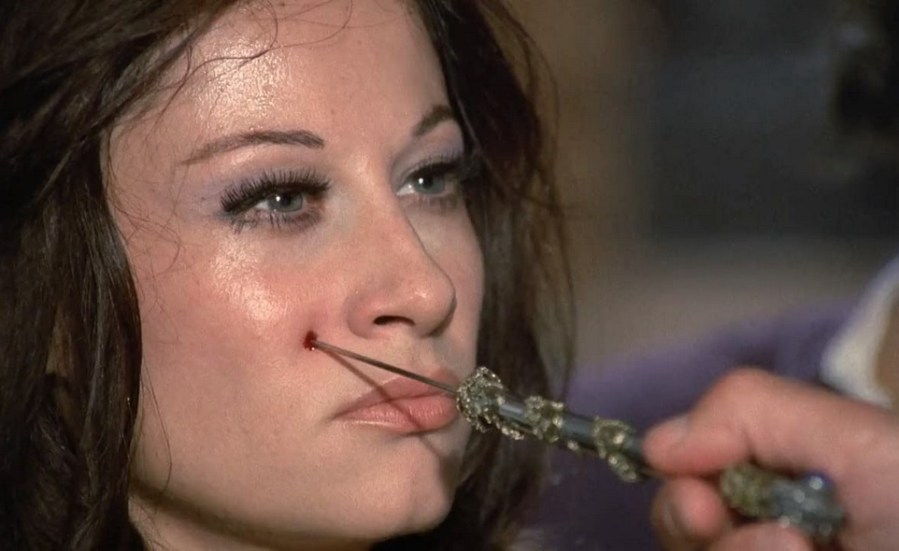
As for Mark of the Devil, its juxtaposition of sex and violence isn’t any more egregious in its intent than are most other movies—mainstream or exploitation. Just the execution of that juxtaposition goes farther here (every time you see a movie or TV show with a good-looking actor or actress holding and using a gun, you just watched a show that is going for the exact same thing Mark of the Devil is going for: prurient arousal through violence). Where Mark of the Devil gets its own marks is for being honest in its calculations (for irony on this point, check out that video from a few years back that featured all those faux-sincere Hollywood “useful idiots” decrying gun violence…juxtaposed with clips from their own gun-happy movies).
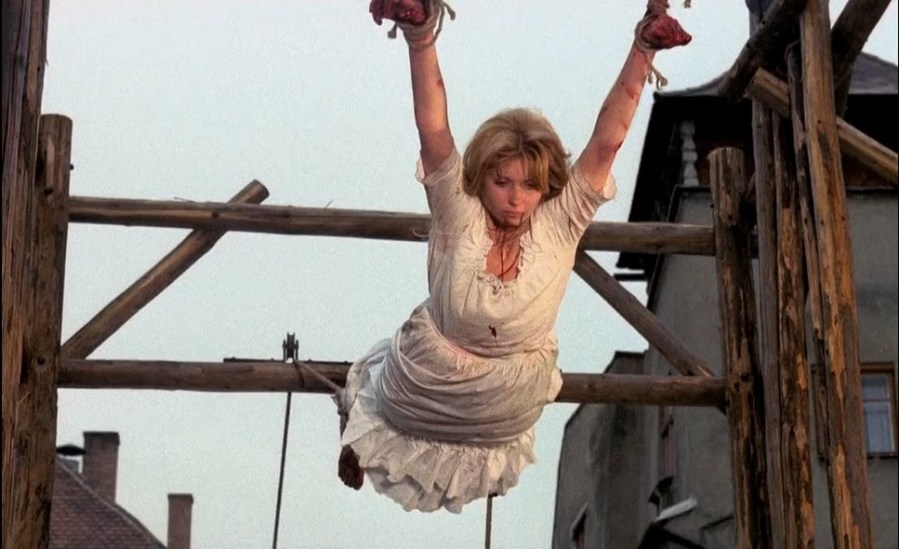
Mark of the Devil wasn’t screwing around back in 1970—it was going to show you what the other movies just teased, like it or not. Sure we’re conflicted when we’re literally wincing at the sight of Gaby Fuchs being stretched on the rack…only to notice how good her naked body looks. That’s the moral breaks for this kind of movie: it puts you in a very uncomfortable—or a pleasurably naughty—position that you can squirm about later (…or you can do it the safer Tarantino way: lay on an old Ironside music cue you stole, get some beloved has-been actor to do the knife work, throw in a few lame jokes, and the critics will wet themselves thinking up superlatives for your borrowed product).

However, where many reviewers find Mark of the Devil‘s seemingly unending sequences of torture queasy, sensationalistic overkill, I find it relentlessly fatalistic, like a Grimm’s Fairey Tale come to horrific life (the movie’s familiar political angle, while interesting—the Church allowing witchhunts for financial gain—doesn’t break any new ground, having been explored in the 1968’s The Witchfinder General). There’s just no escape from this overwhelming feeling of dread and horror and perversion in this movie.
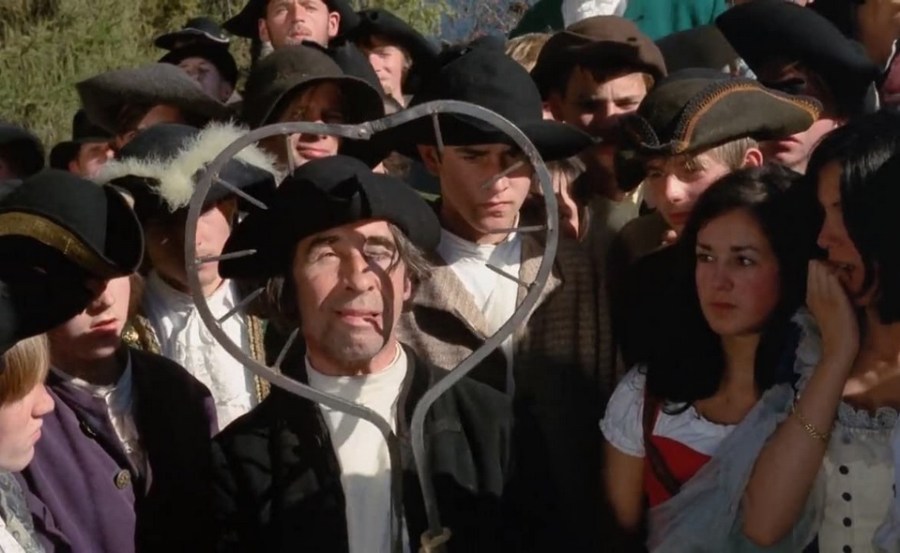
Sickening violence is random and unexpected (the lovers who just happen to be in the wrong spot at the wrong time, the stabbing of the nobleman in front of his shocked guests and children), and the torturing doesn’t stop, long after we expect it to because of our conditioning from so many other movies we watched, where such things are done discreetly off-camera, and for just a few seconds. We get no relief or respite from the heinous goings-on here.
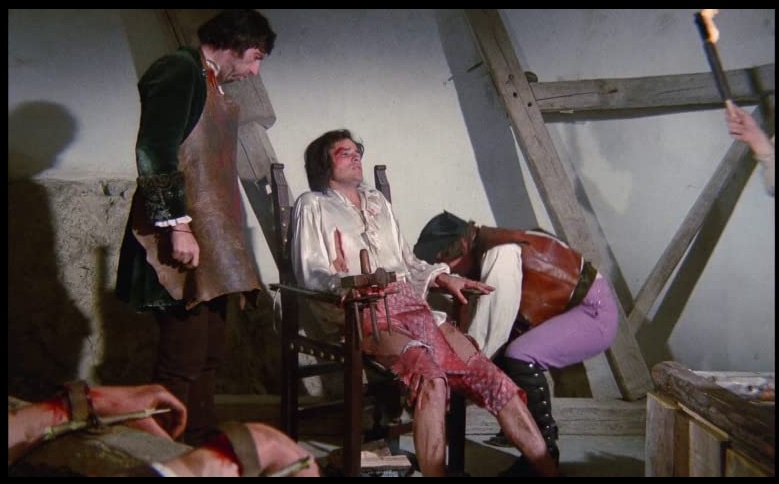
One of Lom’s victims, the wealthy Baron Daumer (Michael Maien), is tortured mercilessly, over and over again, far past the point where we think the movie will drop it and move on to someone else, and then as a pay-off, SPOILERS ALERT! he’s beheaded (!) at the last moment before help arrives. So much for resolution. Christian, whom we’re asked to identify as the movie’s “hero,” is really just a wishy-washy enabler of Lom’s torture, who takes forever to morally evolve…only to ironically get his just desserts (after “saving” the Baron and releasing Vanessa) from the marauding—and now torturing—townspeople…while Lom escapes scot-free.

Sure Mark of the Devil is choppy and badly-directed at times (this could be down to possibly having two directors: credited director Michael Armstrong and producer Adrian Hoven, who also wrangled over the script during the movie’s troubled production), with silly, anachronistic dubbed-in dialogue (“I’ll bet he’s not so horny now!” a townsperson screams when a convicted priest is tarred and feathered). But if you want your fairy tales with an unfettered, utterly relentless sense of nightmarish horror, Mark of the Devil is tough to beat.


P.S.: However…if you’re still indignant about Mark of the Devil‘s unending compendium of gore, including its most notorious scene—a woman’s tongue being pulled out, in grotesque close-up, with a pair of tongs—just remember: the year before, Dennis Hopper had his fingers chopped off in full Vienna-sausage-flying Technicolor glory in that beloved G-rated, Oscar-winning John Wayne family-friendly oater, True Grit. And nobody said a peep about it.
Betcha don’t feel so superior and self-righteous now, do you?

Read more of Paul’s film reviews here. Read Paul’s TV reviews at our sister website, Drunk TV.

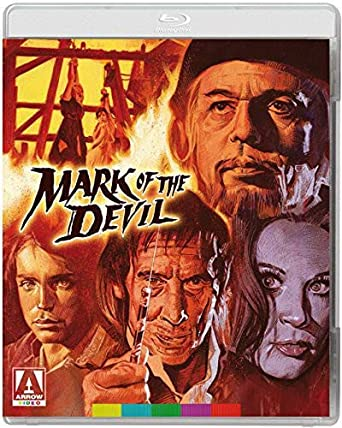

this is one of the worst articles ever written
LikeLike
I’m joking
LikeLike
I’m board
LikeLike